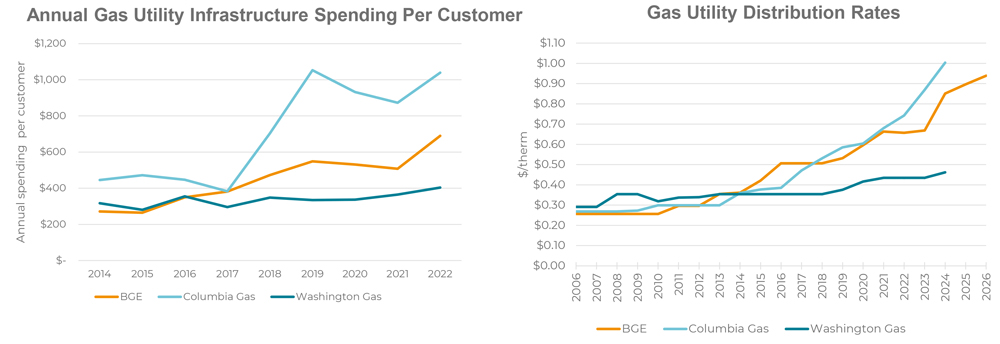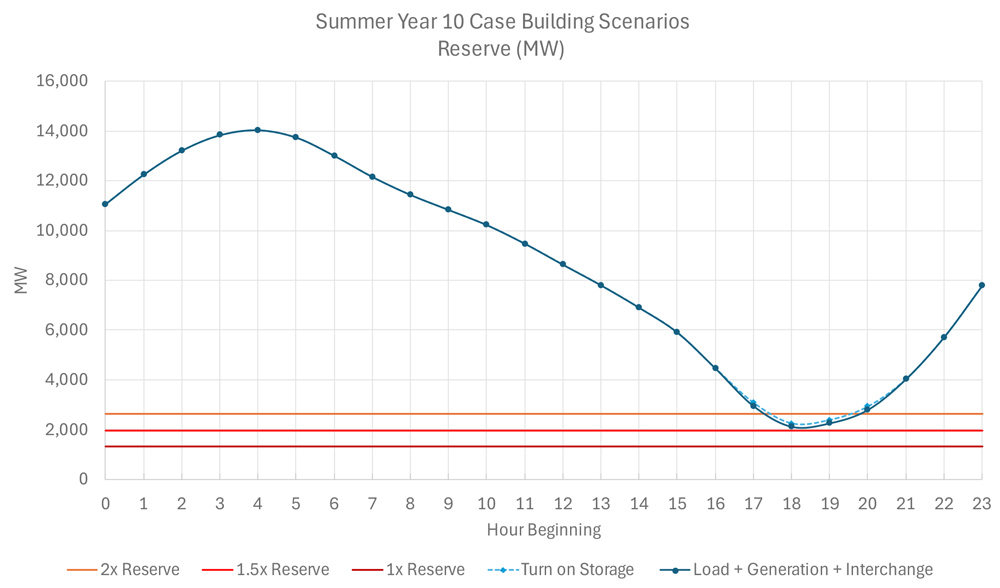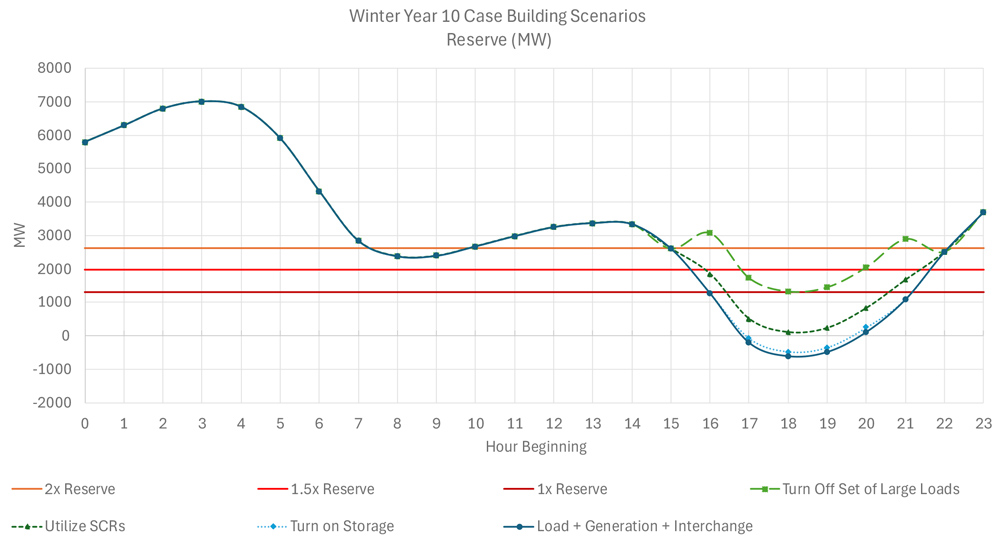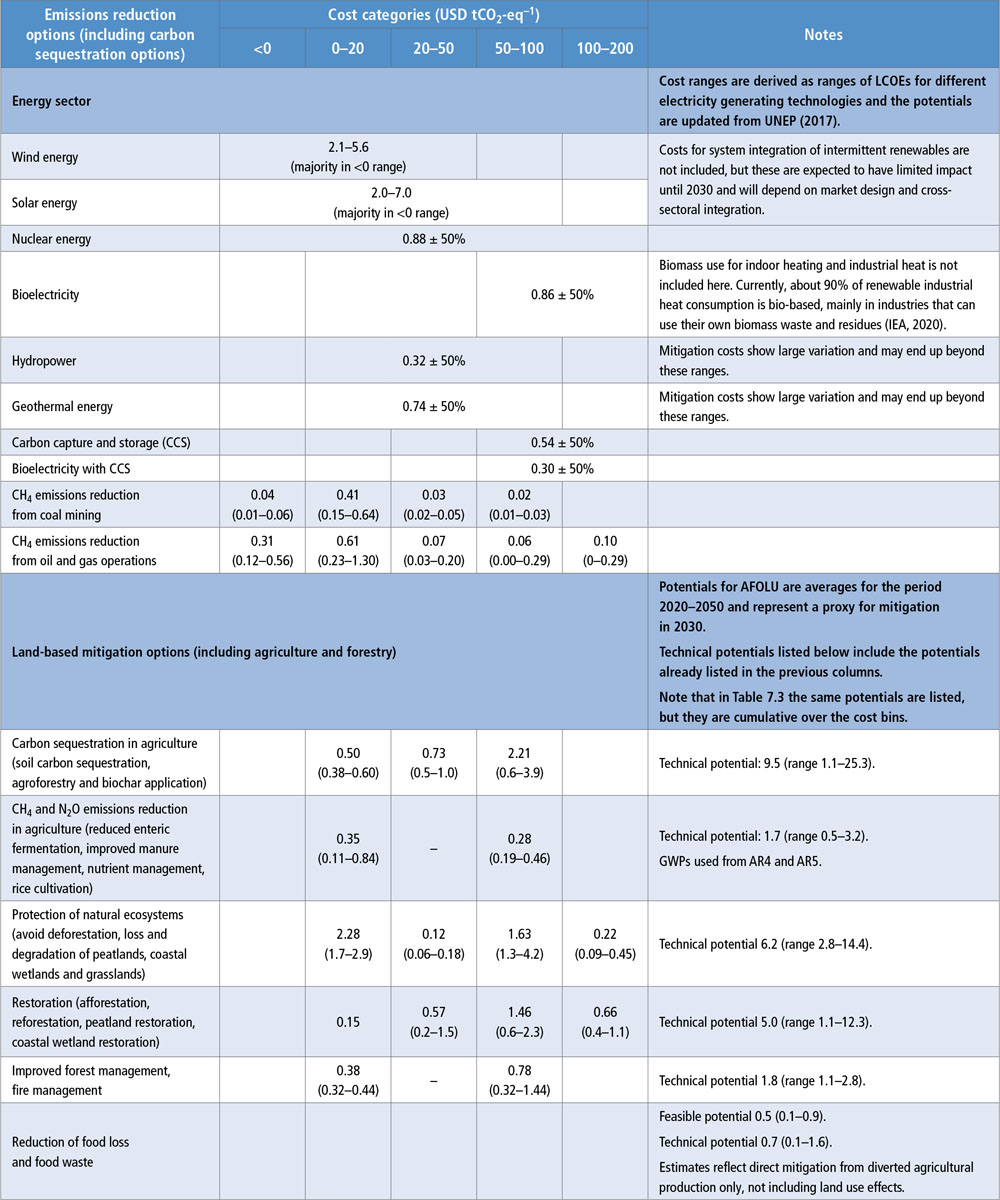Stakeholders Endorse Reserve Rework, Reject Procurement Flexibility
VALLEY FORGE, Pa. — PJM’s Markets and Reliability Committee endorsed one of two proposals to revise how PJM uses reserve resources, approving a deployment scheme where instructions are sent by basepoints, while rejecting a parallel proposal to grant operators the ability to dynamically increase market procurements. (See “First Read on 2 PJM Proposals to Revise Reserve Markets,” PJM MRC/MC Briefs: June 27, 2024.)
PJM’s Emily Barrett said updating basepoints with reserve instructions provides more clarity around how resources are expected to respond and allows for units to be dispatched for less than their full reserve assignment. Resources being asked to respond at less than their assignment will be committed at the greater of their economic minimum parameter or the pro rata instruction.
Stakeholders rejected a second proposal to determine the amount of 30-minute reserves PJM commits using a formula rather than the static 3,000-MW figure. The equation would select the greater of the load forecast error and forced outage rate together multiplied by the forecast peak load, the primary reserve requirement or the largest active gas contingency.
The package also would have allowed operators to increase one of the three reserve categories without having to increase all three. Under the status quo language, any out-of-market increase in the 30-minute, primary or synchronized reserve requirement must be mirrored across all three. Barrett said the language tying the three reserve products together is viewed by staff as an oversight.
Prior to the vote, PJM’s Executive Director of System Operations Dave Souder said the static reserve threshold is not sufficient and does not account for risks identified by dispatchers. The proposal would revert to the reserve procurement formula in place before the reserve price formation redesign.
Paul Sotkiewicz, president of E-cubed Policy Associates, said outages experienced in Alberta, Canada, in April demonstrated the importance of having dispatchers able to match reserves with expected risk.
“The Alberta outage a few months ago shows why this is needed. The renewable forecast was inaccurate, energy commitments were too low and firm load had to be shed. That provides a cautionary tale that lends support for the ability to commit more reserves available,” Sotkiewicz said.
According to the PJM summarized voting report, the reserve procurement package had little support among electric distribution companies, which were 93.1% opposed, and end-use consumers, who voted 82.4% against. The Other Suppliers sector was split at 57.1% support, while generation and transmission owners were united in support.
Responding to a stakeholder question about whether PJM would consider moving forward with the proposed tariff changes without stakeholder endorsement, PJM Vice President of Market Design and Economics Adam Keech said staff had not envisioned the vote failing and will have to consider next steps.
Schedule Selection Formula Endorsed
Stakeholders endorsed a proposal to use a formula to sift through market sellers’ energy offers into the real-time market and select one schedule for each resource to be modeled in the market clearing engine (MCE). (See “Stakeholders Discuss Path Forward on Multi-Schedule Modeling,” PJM MIC Briefs: June 5, 2024.)
PJM brought the issue before stakeholders as part of its effort to implement multi-schedule modeling in the real-time market, which staff have said would result in a significant increase in computation times, in part due to the number of configurations combined cycle units can operate under. The introduction of multi-schedule modeling is one part of a larger overhaul of the engine under PJM’s Next Generation Markets (nGEM) initiative.
An earlier schedule selection proposal was endorsed by stakeholders but rejected by FERC in March. The commission cited a “crossing-offer-curves” scenario the Independent Market Monitor raised, under which PJM’s proposed formula would select market-based offers based on its dispatch cost at EcoMin even if it would be notably more expensive than a cost-based offer at higher outputs.
The proposal endorsed July 24 is built around the same formula but aims to address the crossing curves issue by selecting price-based offers only when a resource passes the three pivotal suppliers (TPS) test and mitigating resources to their cost-based offers should they fail the TPS test. The tariff and operating agreement (OA) revisions are set to go before the Members Committee on Aug. 21 for an endorsement vote.
The proposal was sponsored by PJM and the GT Power Group at the Market Implementation Committee and received the second-highest amount of support at the MRC in December. (See “Stakeholders Endorse Multi-schedule Modeling Solution,” PJM MRC/MC Briefs: Dec. 20, 2023.)
Monitor Joe Bowring said the joint proposal would not resolve an issue with how dual-fuel units are committed. Since only one schedule is considered, the Monitor has argued that dual fuel units may be selected to run on a schedule using a fuel that is not economical for a portion of the day.
Stakeholders had discussed waiving truncated voting rules and widening the vote to include a joint proposal from the Monitor and GT Power, which would allow generators to determine which of their offers would result in the lowest production cost and should be modeled in the MCE.
Vote on Enhanced Know Your Customer Deferred
The committee delayed voting on a proposal to tighten PJM’s “know your customer” (KYC) requirements to require more due diligence checks on principals and key decision makers among member entities. (See “First Read on Expanded ‘Know Your Customer’ Rules,” PJM MRC/MC Briefs: June 27, 2024.)
The proposal would require PJM background checks on beneficial owners, board of director members and principals of non-publicly traded members. Those entities would be responsible for providing a list of names for each of those categories and government-issued identifications, though the latter does not apply to boards unless requested by PJM. The proposal is aimed specifically at collecting more information on non-public members not required to report ownership information to the Securities and Exchange Commission.
The beneficial owner definition is applicable to those who own, control or hold 10% or more voting power of an entity, either directly or with family. Since the June 27 first read, Assistant General Counsel Eric Scherling said the definition of family members was clarified to state that ownership split across spouses, domestic partners, parents, children or siblings counts toward triggering the requirement.
The proposed definition of “principals” also was revised to add the phrase “corporate-level strategy” regarding the control individuals have over the member entity’s operations. Scherling said the change is meant to address feedback that the definition could be too broad and capture staff with day-to-day operational control over assets.
Several stakeholders said they would need more time to review the changes and expressed continued concerns about the scope of the requested information.
Sotkiewicz said the principal definition remains nebulous when considering parent corporations and subsidiaries with split ownership. He motioned to defer voting until the Aug. 21 MRC meeting to provide more time to review the revised language.
“This is an arduous process for people [who] happen to be partners but don’t necessarily have full decision-making authority. … This could turn into a paperwork nightmare and for what reason we’re not entirely sure” when the parent company is publicly traded and the ownership is clear, he said.
John Horstmann, senior director of RTO affairs for Dayton Light and Power, said some members have widespread operations that go far beyond PJM markets and that principals managing activities unrelated to PJM could be captured in the KYC requirements. He gave the example of an international corporation that does business in the U.S. and overseas, questioning whether information about corporate staff overseeing activities in Bulgaria or Vietnam would be requested by PJM.
Scherling said PJM’s focus is on its markets and intends to take a closer look at individuals who are high enough in the corporate structure they would have a hand in all operations, including PJM.
PJM Chief Risk Officer Carl Coscia said the KYC structure is about following where PJM revenues are going, what they’re being used for and where investments are coming from, so it does need to go to the highest corporate-level strategy.
“We want to make sure these markets are being used for good. That’s the good we’re talking about, not having money that shouldn’t be here,” he said.
Scope for Deactivation Task Force Widened
Stakeholders endorsed a wider scope for the Deactivation Enhancement Senior Task Force (DESTF) to include proposals to establish cost-effective alternatives to reliability-must-run (RMR) agreements and technologies that could expedite resolution of transmission violations prompted by resource deactivations. The proposal passed with 89% support. (See “Consumer Advocates Seek Wider Scope for Deactivation Task Force,” PJM MRC/MC Briefs: June 27, 2024.)
The revisions to the issue charge also include education on the alternatives to RMR contacts that other RTOs have developed to keep generators operating past their desired deactivation date and a follow-up to ongoing discussion on proposals to allow capacity interconnection rights (CIRs) to be transferred from deactivating generators to planned resources. The proposal is sponsored jointly by the Illinois Citizens Utility Board (CUB) and Maryland Office of People’s Counsel (OPC).
The issue charge language includes education around using grid-enhancing technologies (GETs) and storage as a transmission asset (SATA) to expedite transmission upgrades necessary to allow a generator to retire.
Souder said PJM is neutral toward the technology that resolves an identified violation and it’s up to project proposers to submit solutions, including GETs.
Clara Summers, of CUB, said the proposed language was revised from the draft presented at the June 27 first read to allow partial solutions, with the goal of avoiding any interruption to the existing discussions on compensation and deactivation notification timelines.
Vistra’s Erik Heinle said he is concerned about having too wide of a scope for the task force, stating that the wide-ranging issue charge governing the Resource Adequacy Senior Task Force (RASTF) caused the group to die under its own weight while the Reserve Certainty Senior Task Force (RCSTF) has benefited from a narrower scope.
“I want to make sure these important issues get the consideration they deserve but don’t slow down the ongoing work,” he said.
Bowring questioned whether the advocates believe the issue charge should be phased to focus on deactivation notification requirements and compensation first before initiating work on the newly added items.
Phil Sussler, of the Maryland OPC, responded that stakeholders may be too optimistic that the deactivation notification changes will be approved in August and said the overall work areas of the DESTF may take longer than expected to complete.
Reserve Requirement Study Updated with ELCC Accreditation Values
The committee voted by acclamation to endorse revised installed reserve margin (IRM) and forecast pool requirement (FPR) values for the 2023 Reserve Requirement Study (RRS) to reflect the implementation of PJM’s marginal effective load carrying capability (ELCC) approach to accrediting resources. The proposal also was endorsed by the Members Committee on July 24.
The reanalysis recommended increasing the installed reserve margin (IRM), which sets the targeted capacity level above expected loads, to 18.6%, up from the 17.6% stakeholders endorsed last year for the 2023 RRS. The forecast pool requirement (FPR), which accounts for generator accreditation, would decrease from 11.65% to 9.37.
The shift to marginal ELCC accreditation was part of a package of capacity market redesigns approved by FERC in January (ER24-99). The RRS figures are used to set the supply curve for the 2026/27 delivery year. (See PJM Presents Revised Reserve Requirement Study Values.)
In addition to the ELCC accreditation values, the reanalysis updated the expected resource mix to include planned resources that submitted a notice of intent to offer into the 2026/27 Base Residual Auction. Gas generators that submitted dual fuel attestations were sorted into the corresponding ELCC classes, and resources that are scheduled to deactivate prior to the start of the delivery year were removed from the analysis. Generators expected to operate on reliability-must-run (RMR) contracts through the delivery year were included in the resource mix.
Greg Carmean, executive director of the Organization of PJM States Inc. (OPSI), questioned how PJM would incorporate nuclear capacity being removed from the market to serve data center load, referring to a FERC filing from Talen Energy to reduce the amount of energy the Susquehanna nuclear plant sells into PJM. (See Talen Energy Deal with Data Center Leads to Cost Shifting Debate at FERC.)
PJM’s Andrew Gledhill said the megawatt value of that unit would be effectively derated to the new CIR amount.
Bowring asked how PJM considers the reliability impact of amending interconnection service agreements (ISAs) with generators to reduce their maximum output and whether it considers not approving revisions if there are reliability impacts identified.
PJM’s Pat Bruno said reliability analysis is conducted like generation deactivation studies.
PJM Proposes Increased CONE Parameters
PJM’s Skyler Marzewski presented a first read on a proposal to revise two financial parameters used to calculate the cost of new entry (CONE) input to the 2027/28 Base Residual Auction (BRA). (See PJM MIC Briefs: July 10, 2024.)
After consulting with The Brattle Group, PJM recommended increasing the after-tax weighted average cost of capital (ATWACC) from 8.85 to 10% and using a 0% bonus depreciation rate for the 2027/28 delivery year and beyond. The original quadrennial review included a 20% bonus depreciation value for the 2026/27 year. The proposed changes to the quadrennial review also would update the Bureau of Labor and Statistics (BLS) indices used in capital cost escalation rates.
The changes increase values for all five CONE areas by an average of $79/MW-day, with CONE Area 5 seeing the largest increase at $90/MW-day and Area 4 increasing by $65/MW-day.
The review was triggered by market participants reaching out to PJM regarding the impact of high interest rates since the quadrennial review was approved last year. (See FERC Approves PJM Quadrennial Review.)
Greg Poulos, executive director of the Consumer Advocates of PJM States (CAPS), said some advocates are frustrated that components of the review are being cherry-picked in a manner that increases consumer costs, both in terms of the financial parameters and the creation of an additional CONE area for Illinois. (See PJM Stakeholders Approve New CONE Area for ComEd over Consumer Opposition.)
Summers questioned how PJM determines when it is appropriate to make changes to CONE outside of the quadrennial review.
Marzewski said PJM and Brattle opted to not include automatic adjustments to the quadrennial review financial parameters to account for changing market conditions, instead leaving that discussion for the next quadrennial review.
Sotkiewicz said the adjusted figures would be a short-term fix, but major issues remain with the CONE inputs, namely the use of a combined cycle generator as the reference resource at a time when few such units are under construction within PJM and none have been financed in recent years.
New Economic DR Parameters Discussed
PJM presented a proposal to add two new parameters for demand response resources offering into the energy market, allowing providers to set a maximum dispatch period and a minimum interval before they can be committed again after being released from a previous dispatch. The Market Implementation Committee endorsed the proposal last month. (See “Additional Parameters for Demand Response Endorsed,” PJM MIC Briefs: June 5, 2024.)
PJM’s Pete Langbein said the proposal would allow DR providers to enroll consumers that are only economic for set periods of time and need a recharge before being committed again. While some of that capability exists under the existing market structure using hourly updates, it is administratively difficult.
Bowring questioned whether a DR resource could submit an offer into the capacity market even if it can operate only according to the proposed parameters. Langbein said such a resource would be subject to capacity performance (CP) penalties if it did not deliver during a performance assessment interval (PAI).




